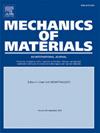A microstructure-based finite element model of the human left ventricle for simulating the trans-scale myocardial mechanical behaviors
IF 3.4
3区 材料科学
Q2 MATERIALS SCIENCE, MULTIDISCIPLINARY
引用次数: 0
Abstract
The hierarchical structure and heterogeneous composition of the myocardial tissue and the differential mechanical properties of myocardial components together make the mechanical behaviors of the left ventricle (LV) highly complex. In the present study, we developed a microstructure-based (MB) finite element model to quantify the time-varying myocardial mechanics of the LV during an entire cardiac cycle while accounting for the mechanical states of individual myocardial components. The modeling work started from building constitutive models for individual myocardial components based on their microstructure and mechanical properties, followed by combining them to form an integrated constitutive model of myocardial micro-tissue that was programmed on the discretized finite elements of the myocardium. Verification/validation studies performed at multiple scale levels demonstrated the good performances of the modeling methods. Numerical simulation for a normal LV reasonably reproduced the typical pressure-volume loop, demonstrated the spatiotemporal changes in myocardial displacement and stress over a cardiac cycle, and revealed the differential mechanical states of cardiomyocytes located in different myocardial regions. Furthermore, the model was applied to address the impact of regional replacement fibrosis. The results showed that replacement fibrosis impaired both the diastolic and the systolic functions, altered the spatial distributions of myocardial displacement and stress, and reduced the systolic cardiomyocyte stress in the fibrotic myocardial region. In summary, the study demonstrated the significance of accounting for the MB mechanical properties of myocardium when modeling the mechanical behaviors of the LV, and the model may contribute as a useful tool for addressing biomechanical problems related to cardiomyopathies.
求助全文
约1分钟内获得全文
求助全文
来源期刊

Mechanics of Materials
工程技术-材料科学:综合
CiteScore
7.60
自引率
5.10%
发文量
243
审稿时长
46 days
期刊介绍:
Mechanics of Materials is a forum for original scientific research on the flow, fracture, and general constitutive behavior of geophysical, geotechnical and technological materials, with balanced coverage of advanced technological and natural materials, with balanced coverage of theoretical, experimental, and field investigations. Of special concern are macroscopic predictions based on microscopic models, identification of microscopic structures from limited overall macroscopic data, experimental and field results that lead to fundamental understanding of the behavior of materials, and coordinated experimental and analytical investigations that culminate in theories with predictive quality.
 求助内容:
求助内容: 应助结果提醒方式:
应助结果提醒方式:


